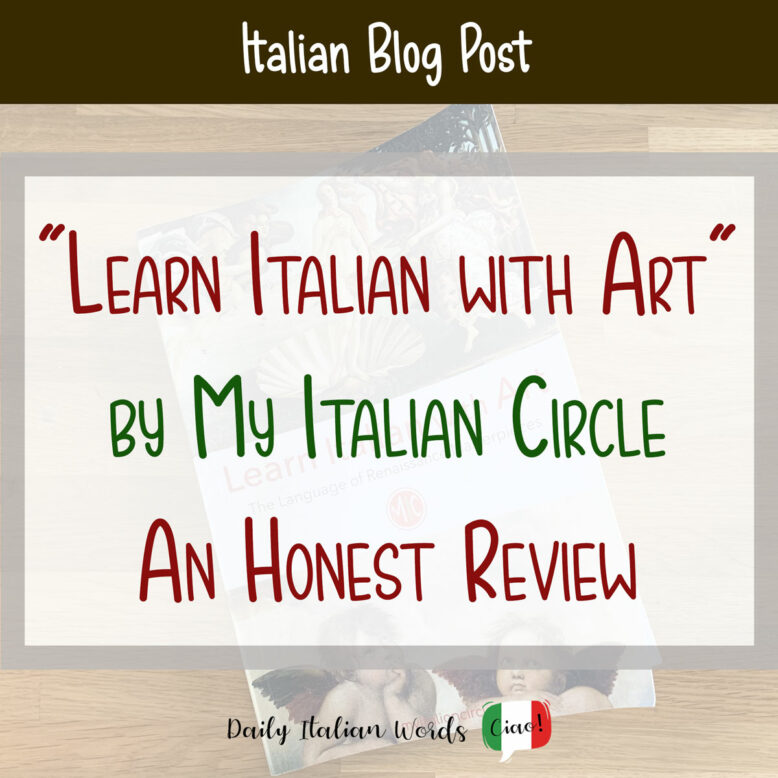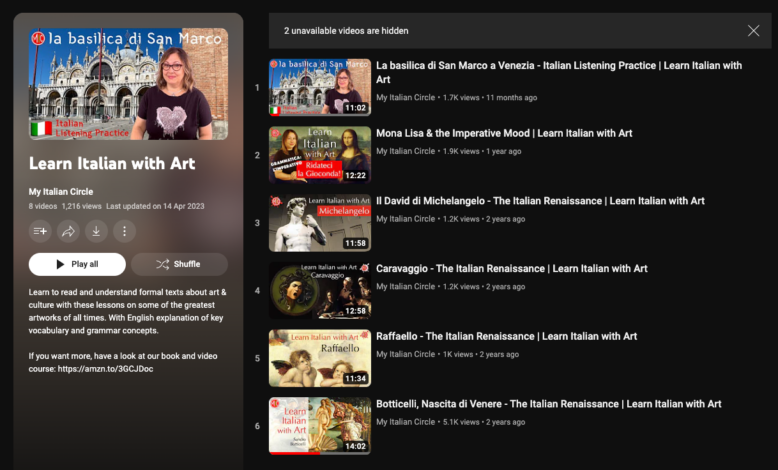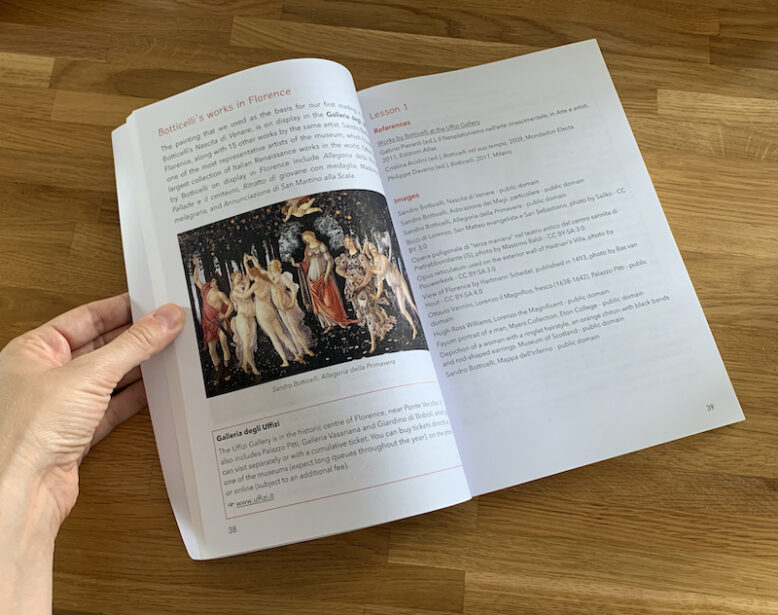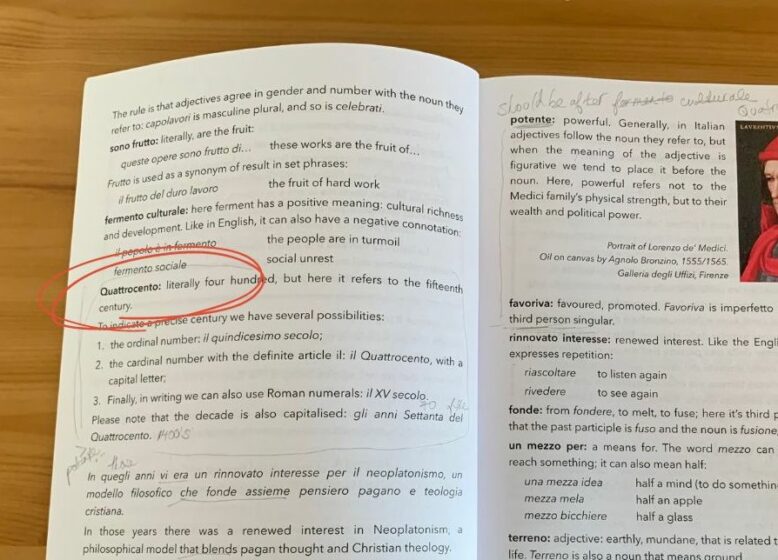When learning a foreign language, it’s vital to concentrate on activities and subjects that genuinely interest us in order to stay motivated. For example, if you’re already an enthusiastic reader like I am, you might wish to incorporate various reading exercises into your study routine. This could include reading uncomplicated short stories in your target language or trying your hand at more intricate novels, using an app like LingQ.
For those with a passion for Italian art, there’s a grammar textbook I would highly recommend: “Learn Italian with Art – The Language of Renaissance Masterpieces” by My Italian Circle.
Within the pages of this book, authors Anna and Diana take you on a voyage through Italy’s most illustrious masterpieces. As you explore these works of art, you’ll also acquire the language skills required to grasp the descriptions accompanying paintings, sculptures, or architectural wonders. Ready to find out more? Let’s begin!

Ethics statement: The following resource was sent to us for review purposes. We were not asked to write anything about this product, nor were we provided with any sort of compensation. Within the article, there are affiliate links. If you buy something after clicking the link, we will receive a small commission. To know more about our ethics, you can visit our full disclosure page. Thank you!
About “Learn Italian with Art”
“Learn Italian with Art” functions as an supplementary grammar textbook meant to complement a comprehensive grammar and exercise guide, or a formal Italian course.
Since its target audience is A2-B1 level learners, it’s crucial to have at least a basic understanding of Italian before delving into this book. Failing to do so might lead to a sense of confusion or being overwhelmed as you navigate through the material.

As you’ve probably already surmised, the book’s emphasis lies on traditional Italian art. Each of its six chapters centres around an academic text that describes a distinct masterpiece from the Italian Renaissance, spanning from Sandro Botticelli’s celebrated “Nascita di Venere” to Caravaggio’s spine-tingling “Medusa.”
Additionally, each chapter is accompanied by a video in which Anna reads the text aloud and provides the English translation. Following each sentence, she identifies key terms and grammar elements, explaining their functions. Although certain segments of the video course are available for free on YouTube, access to the complete videos is exclusively available through a QR code found within the book.

What I like about “Learn Italian with Art”
It puts the language into context
The issue with many textbooks is that they often fail to provide a meaningful context for the vocabulary and grammar they are teaching. They might give you a list of words and grammar rules that, when studied individually, don’t have much significance for a person trying to learn the language.
This specific textbook takes a different approach. It introduces new vocabulary and grammar as interconnected pieces of information, giving you the opportunity to understand how they might be used together in real-life situations where art is the topic of conversation.

Anna speaks very clearly
In the corresponding videos, Anna speaks in a very clear and comprehensible manner. She speaks slowly enough that an A2-B1 learner shouldn’t face substantial challenges in grasping the meaning, particularly after a few repeated listens. If you do find yourself struggling, we recommend pausing the video from time to time in order to fully comprehend the text being spoken. Here is a sample of her speech from the first video course:
Listening to Anna speak and repeating after her will also help you improve your pronunciation.
Comprehensive and complete
Although this isn’t the kind of textbook you can use on its own, it does successfully cover nearly all the most important grammar topics, from the basic presente indicativo (indicative present tense) and passato prossimo (present perfect) to the more challenging passato remoto (remote past) and verbi pronominali (pronominal verbs). This means you can put into practice everything you’ve learned in your exercise book or formal Italian class.
Exercises included
Understanding a grammar rule or hearing a passage being read aloud is one thing, but effectively applying that newly acquired knowledge is a different challenge altogether. To aid in the retention of vocabulary and grammar, each chapter concludes with a set of concise exercises tailored to solidify what you’ve studied. My mother, who is at an A2 level of Italian, was successfully able to complete them without too much difficulty.
What could be improved
Lack of some English translations
While the book includes numerous English translations, I noticed that a significant portion of the vocabulary needed to successfully tackle the exercises at the end of each chapter has not been translated. It is true that some words might be easily understood due to their resemblance to English, but this isn’t always the case. This problem might discourage some learners from using the book, as they could get frustrated having to constantly look up unfamiliar words.

Material in the book and videos sometimes inconsistent
For the most part, what Anna says in the videos aligns perfectly with the textbook material. However, certain paragraphs referenced in the video are located on a different page than anticipated.
For example, on page 16, Anna skips from fermento culturale to potente and favoriva in the video before returning to the previous page with the explanation for quattrocentro.

Thankfully, this doesn’t occur very often, and doesn’t really hinder the learning process.
Final thoughts
It goes without saying that Learn Italian with Art is a niche product within a niche. The book has been crafted not for the typical Italian learner, but specifically for those who have a unique passion for art. Indeed, a significant portion of the vocabulary taught might not be very useful in everyday speech, unless art is a frequent topic of discussion among your friends.
In my view, there’s nothing objectionable about this approach. Considering the abundance of Italian grammar textbooks available, it’s quite refreshing to come across something that offers a unique perspective. Will it sell millions of copies? Probably not, but it will undoubtedly resonate with a specific audience who are passionate about blending language learning with their appreciation for art.
I only wish I had discovered this book before our visit to Italy this past spring, as it would have enhanced my understanding of the city and these great masterpieces!
Within the article, there are affiliate links. If you buy something after clicking the link, we will receive a small commission.
Heather Broster is a graduate with honours in linguistics from the University of Western Ontario. She is an aspiring polyglot, proficient in English and Italian, as well as Japanese, Welsh, and French to varying degrees of fluency. Originally from Toronto, Heather has resided in various countries, notably Italy for a period of six years. Her primary focus lies in the fields of language acquisition, education, and bilingual instruction.


